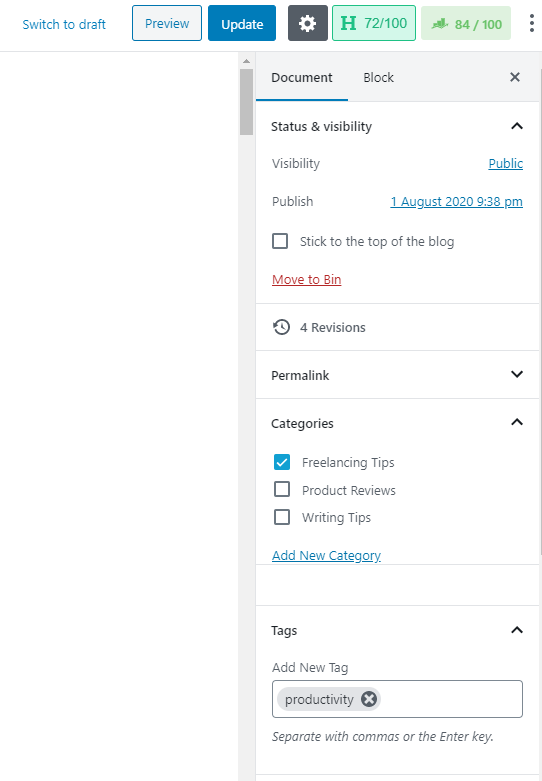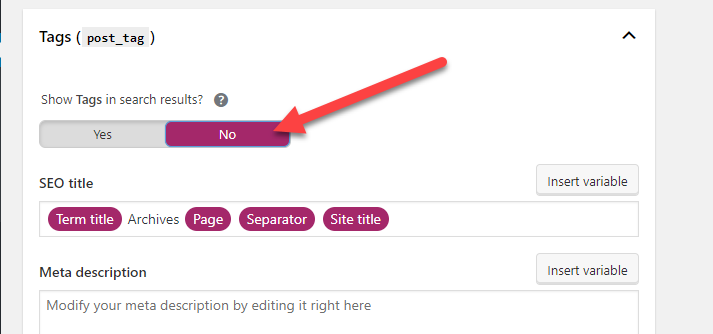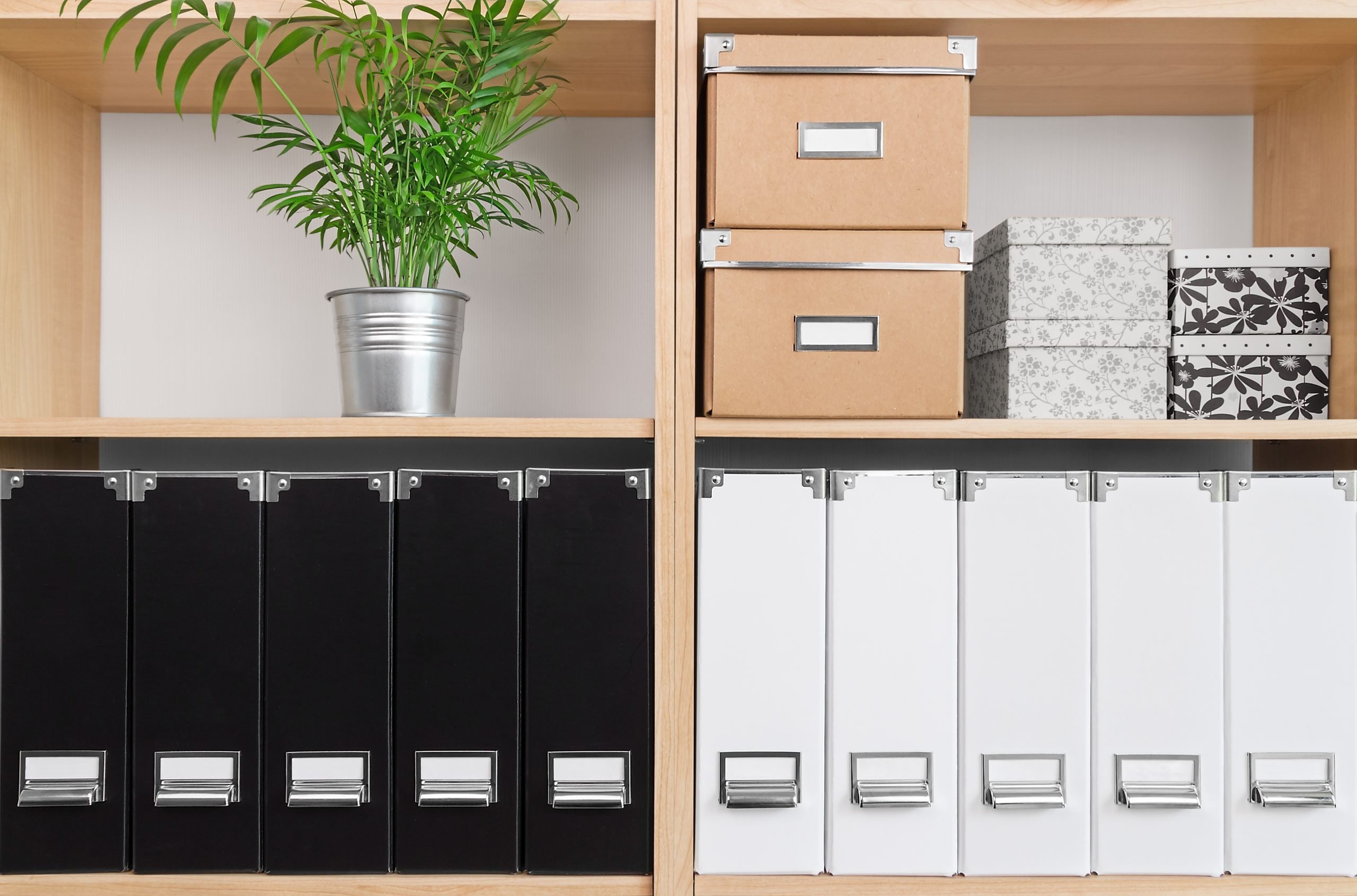If you’re new to WordPress, it’s easy to confuse the purpose of tags and categories.
After all, they almost work the same way:
You assign them to a post and a new page is created that displays all posts labeled with a certain tag or category.
But once you know how they work, using them together is a great way to organize your site and make it easier for your readers to find the content they want.
Here’s what you’ll learn about categories and tags:
- What are WordPress categories?
- What are WordPress tags?
- Categories vs. tags
- How to add categories and tags in WordPress
- SEO tag problems to Avoid
Let’s get started.
What are WordPress Categories?
Categories are the default way to categorize your content in WordPress. They tell both readers and search engines what kind of content lives on your site.
If you have a blog in the health niche, some of your categories might be “healthy eating”, “exercise” and “mental health”.
Your readers can click a category on your blog posts to read more content in the same category. Or, you can add categories to your navigation bar to let them quickly find relevant content.
You should have at least one category for each post. If you don’t create any categories or add them to your posts, everything will go to WordPress’s default category:
Uncategorized.
What are WordPress Tags?
WordPress tags are not like hashtags on Instagram and Twitter.
Trust me, if you were to see 15-30 tags thrown in a post like you see on Instagram, it looks awful.

On top of that, each tag you make creates a new page on your site, which can be a little confusing to search engines.
Like categories, WordPress tags are also a way to categorize a post or page. But unlike categories, you’re not forced to use them. You could go without using tags altogether.
If they’re so similar, what’s the point of having both categories and tags?
Let’s dig a little deeper into the difference between categories and tags.
WordPress Categories vs Tags: The Difference Explained
The main difference between categories and tags in WordPress is this:
Categories are a broad way to categorize your content, while tags are used to define the details of your post.
For instance, you might have a category like “recipes” on your site.
You would use tags to further categorize your posts and pages. You might add a chicken stir fry recipe to the category “recipes” and tag it with “chicken” or “dinner recipe.”
When a reader clicks on the “chicken” tag, they’re brought to something similar to a category page. It displays all of the posts tagged “chicken.”
To sum it up:
You use categories as a broad way to categorize your content and tags to display a more detailed feed.
When Should You Add Categories and Tags?
The best thing you can do when it comes to utilizing categories in WordPress is:
In the beginning, just start with one category. Call it “blog” or something you find catchy and fun.
So when should you start adding categories and tags for WordPress?
Try to aim for 100 blog posts.
I know that sounds like a lot! But hear me out.
How to Categorize Posts on WordPress
While there isn’t a limit to how many categories you can create, it’s important to make sure your blog is focused.
If you stick to a single category until you have lots of content, you’ll be able to see what direction your site has gone and organize content based on your existing topics.
You don’t want more than three categories starting out. If you have a focused niche and a well-planned site, you should only have a few and can add more as you create more articles.
The alternative?
You wind up with lots of unused pages or ones with only a single blog post. These do nothing for your readers or the search engines.
Then, you have to do a lot of cleaning up and set up redirections for all the tags and categories you don’t need down the line.
It’s a huge hassle—I’ve been through it with my own personal sites when I first started blogging. I started out writing about one thing, then took a different direction that didn’t involve a lot of the tags I was using.
I had to set up about 80 redirects and completely change the way I organized my blog posts!
How to Add Tags and Categories in WordPress
It’s easy to add tags and categories in WordPress right from the post you’re working on:

Just click “Add New Category” under your Document Settings to add a category.
For tags, just type the name of the tag you want to add and hit Enter or place a comma.
You can also add and manage categories from your WordPress dashboard under Posts. Here, you can also delete and edit categories and tags.
SEO Tag Problems to Avoid
At most, you only want a combined six to eight tags and categories.
In general, you should only have a single category per post and one to two tags per post. Otherwise, you get lots of issues with competing pages.
Many posts don’t need tags at all. Only create tags once you have a lot of posts that would fit that tag.
For instance, if you have a social media category and focus a lot on Facebook, you could add a “Facebook” tag.
But if you only have a couple of posts about Instagram, wait to create a tag until you have more content to fill it. Readers can easily search “Instagram” on your site and find what they’re looking for—they don’t need tags.
Avoid this Rookie Mistake
You also want to avoid having too many posts that are in multiple categories or share similar tags. Categories and tags should be unique—if they share lots of similar posts, they’re not helpful to readers and can create pages that compete with each other for rankings.
As far as a search engine is concerned, tags and categories (functionally) don’t impact SEO. They’re mostly there to make it easier for readers to navigate your site.
However, there can be a problem if you’re indexing all your tags.
Every time you create a tag, you’re creating another page for search engines to index. Due to how similar they can look to category pages, it’s easy to cause pages to compete with each other.
So what’s the fix?
How to Fix Duplicate Content Issues
The easiest thing is just to make sure your tags aren’t indexed. Most SEO plugins for WordPress have an option to turn off indexing for tags and categories, so you can just go in and set it to “noindex.”

However, if you have enough content or you can make tag pages unique enough to avoid issues with duplicate content, there is another solution.
You can create unique copy for each tag and make sure the titles don’t match up with any of your categories. You’ll also want to make sure that most of them show a different selection of articles and aren’t too similar to what category pages are displaying.
However, this is a lot of extra work for something that won’t have a huge impact on your SEO. In general, it’s better just to avoid indexing most tags.
Wrapping It Up…
Now you understand the difference between tags and categories, as well as how best to organize your site with them.

Just remember there isn’t a single right way to use them. It’s highly dependent on your site, niche and how much organization you need. Figure out what works best for you and when in doubt, just think of what will make things easiest for your readers.

